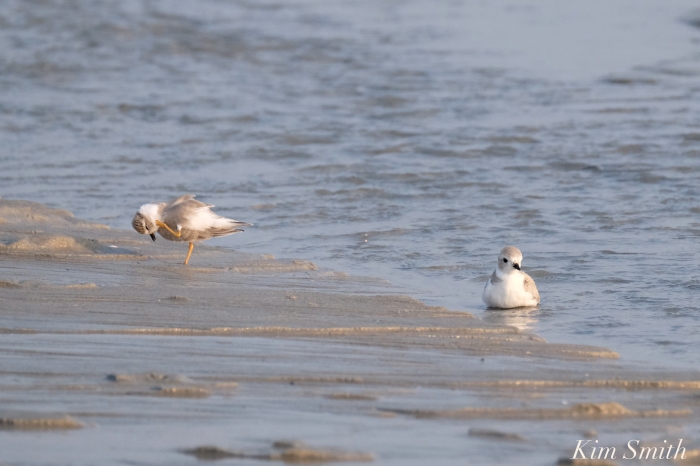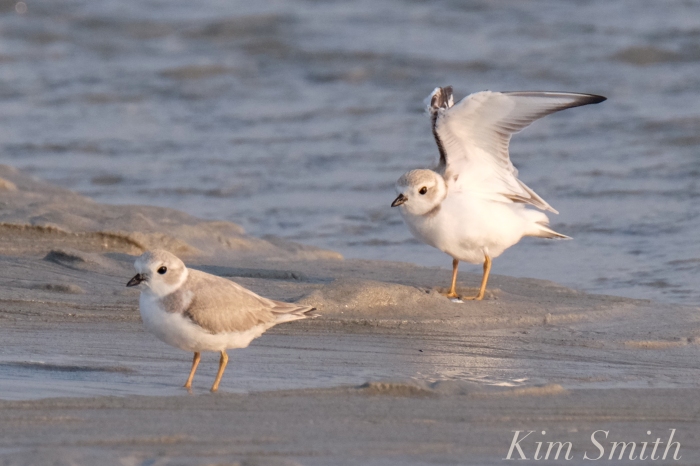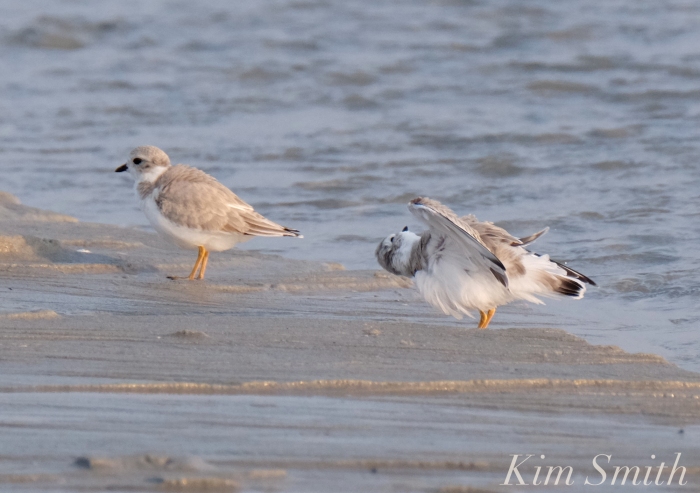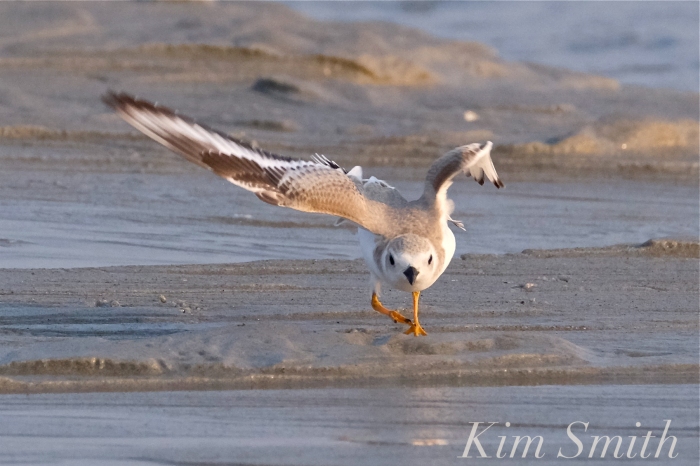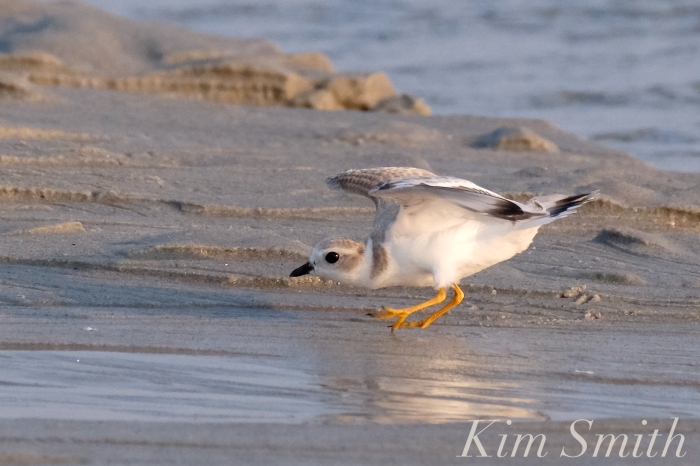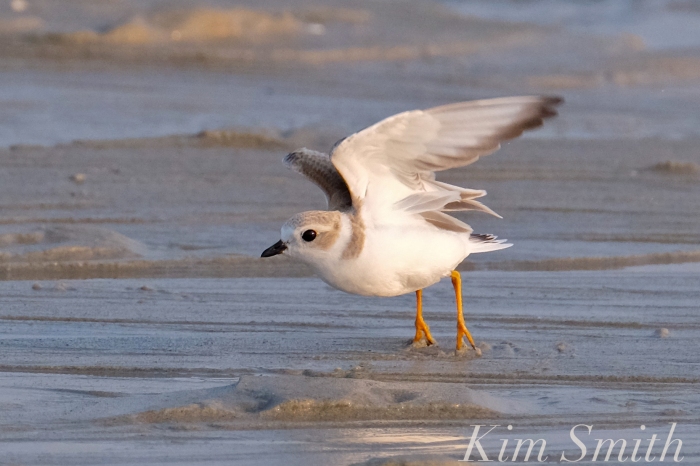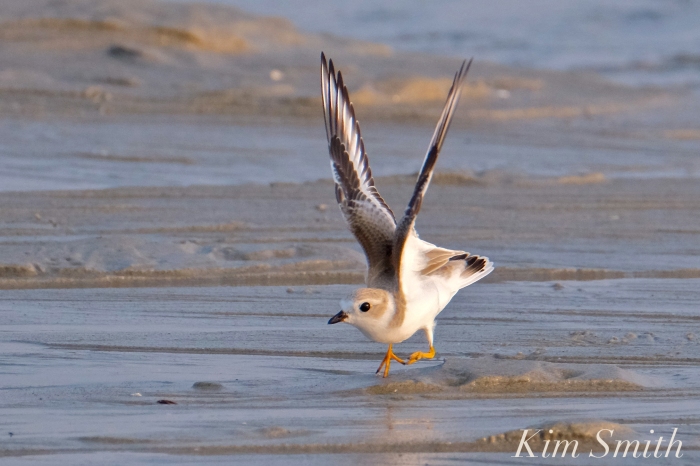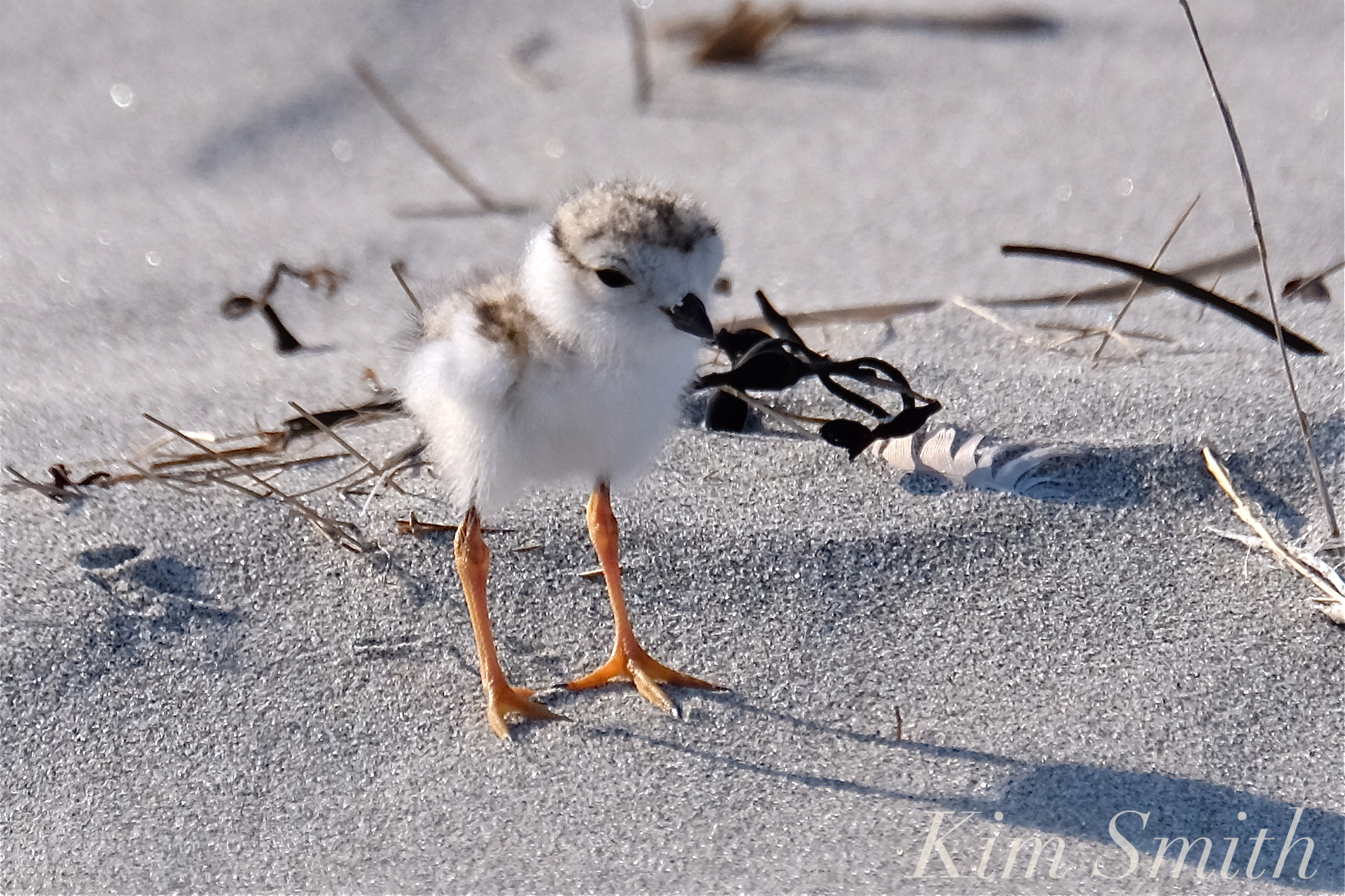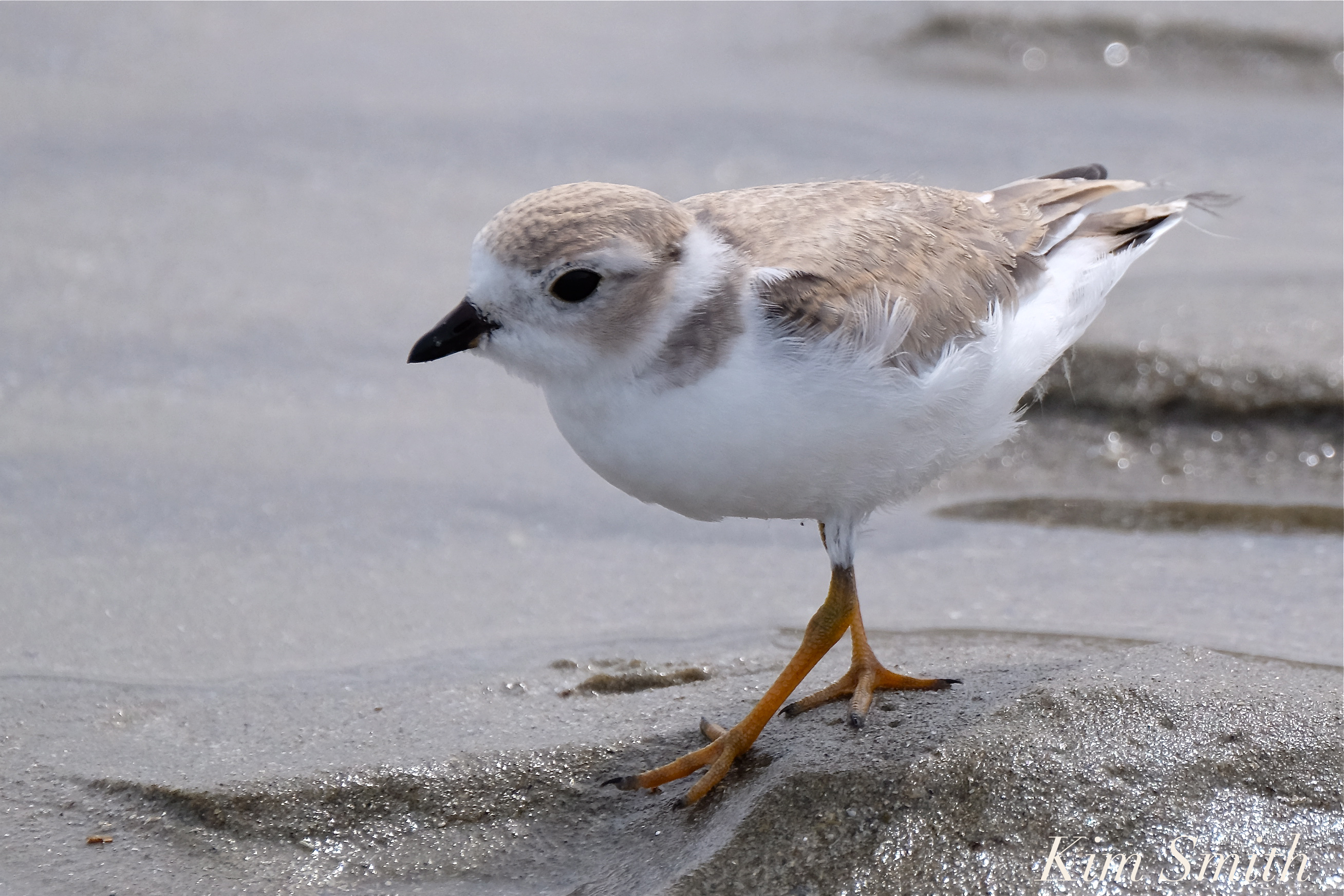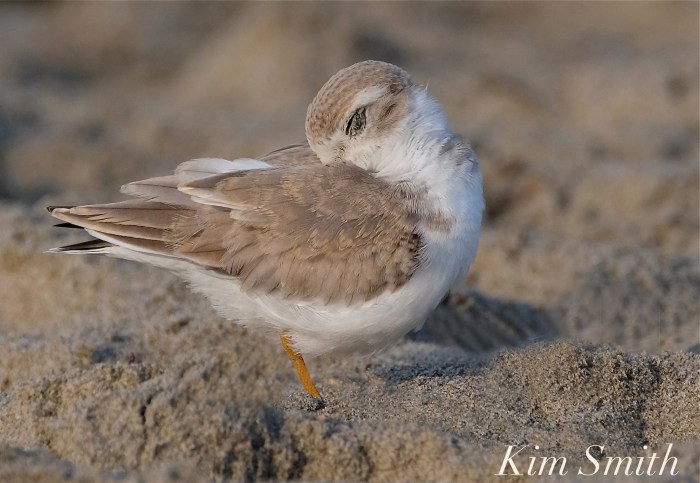 Our six-week-old Little Chick has begun his southward journey. At sunrise this morning I found him sleeping in front of the roped off area. Way down by the water’s edge, was a small flock of three Piping Plovers, but the light was so soft I could not tell if they were males, females, or fledglings. Sensing Little Chick’s time to depart was nearing, I didn’t want to investigate just then, but stayed on the beach to film our plover.
Our six-week-old Little Chick has begun his southward journey. At sunrise this morning I found him sleeping in front of the roped off area. Way down by the water’s edge, was a small flock of three Piping Plovers, but the light was so soft I could not tell if they were males, females, or fledglings. Sensing Little Chick’s time to depart was nearing, I didn’t want to investigate just then, but stayed on the beach to film our plover.
Little Chick awoke with his usual stretching routine and then made his way through the tidal flats mostly eating, but stopping several times to arrange his feathers. In no time he was foraging alongside the three migrating Piping Plovers and, within mere moments he, and the Piping Plover flock, flew, not along the beach or over to the creek as he has been doing, but this time, first straight out to sea and then curving around and disappearing behind the Sherman House.
I stopped by Good Harbor Beach several times later this morning and again in the afternoon, as have several of the volunteers, and no one has seen our Little Chick. Although feeling somewhat melancholy (but also very happy) to see him depart, this is the best possible outcome. We can all hope his journey is a safe one. And we hope too, that he parents many offspring!
 We have been treated to a window into the world of nesting Piping Plovers. Most species of shorebirds breed many thousands of miles away, in the Arctic tundra of Canada and Alaska. We were blessed to see this beautiful story unfold, despite taking place in the least of safe habitats.
We have been treated to a window into the world of nesting Piping Plovers. Most species of shorebirds breed many thousands of miles away, in the Arctic tundra of Canada and Alaska. We were blessed to see this beautiful story unfold, despite taking place in the least of safe habitats.
The greatest thanks to all the Piping Plover volunteers: Carol Ferant, Caroline Haines, Jeannine Harris, Hazel Hewitt, Charles King, Cliff King, George King, Paul Korn, Chris Martin, Lucy Merrill-Hill, Diana Peck, Ruth Peron, Catherine Ryan, Karen Shah, and Ken Whittaker. Without their daily monitoring of people, balls, dogs, gulls, crows, and what have you, we most assuredly would not have seen our Little Chick grow into a fledgling. Thank you too for their eagerness in sharing information about the PiPls with interested beachgoers. There is still a great deal about Piping Plovers that is a mystery. Studying the life story of one plover family creates a focusing lens from which we can all learn. I’d like to add special thanks to volunteer Hazel Hewitt who created the informative signs describing the PiPl that you may have seen all around the beach entryway ways.
If you see Ken Whittaker, Gloucester’s conservation agent, please thank him for all his help. After I discovered the Piping Plover nest on May 23rd, I spoke with Dave Rimmer to let him know precisely where the nest was located, and Ken immediately became available to lend a hand. In a way, we can thank Sharon Bo Abrams, too. After reading about how we were struggling to keep last year’s chicks alive, it was she who suggested that we form a group of volunteers. I mentioned this to Dave, who in turn spoke with Ken. It was Ken who spearheaded the volunteer effort and organized the group’s schedule so that at all times of day, from sunrise to sunset, someone was on the beach monitoring the Plover family. We can also thank Ken for listening to us volunteers regarding the importance of leaving the symbolic fencing in place as long as the chick was using it as his “safety zone.”
Thank you to Mayor Sefatia, Chris Sicuranza, and Frank DiMecurio for their interest and support. Thank you to all our readers for your kind comments and interest in the Plover daily updates.
Thank you to Gloucester Police Chief John McCarthy and Gloucester’s Animal Control Officer Dianne Corliss for their help monitoring the dog owner situation. They both made Good Harbor Beach part of their routine and their mere presence has made a tremendous difference.
A huge shout out to Gloucester’s Department of Public Works Mike Hale, Mark Cole, and Joe Lucido, and the DPW’s team of beach cleaners and rakers, who always went out of their way to keep an eye out for Little Chick and helped keep him safe.
Thanks is owed to Gloucester’s volunteer beach-picker-uppers who, on a daily basis, before everyone else arrives to enjoy the beach, are out there cleaning up what was left from the night before and helping to prevent a plethora of plastic from contaminating the ocean. Three who come to mind immediately, and who have been taking care of Good Harbor Beach for years are Patti Amaral, and husband and wife Patti and Kerry Sullivan. By cleaning the beach, it helps tremendously to keep down the crow, gull, and coyote populations, all of which are predators of shorebird eggs and chicks.
Thank you Community! Without your support, care, and kindness I would not be writing this thank you note.
Several readers have suggested that I write a children’s book, with photographs, about The Good Harbor Beach Little Chick. While I am giving this idea serious consideration, I would only want to undertake a project like this with a top-notch publisher.
Perhaps Papa Joe and Mama Joy will return to Good Harbor Beach for a third year. With less than 8,000 Piping Plovers remaining in the world, we can only hope.
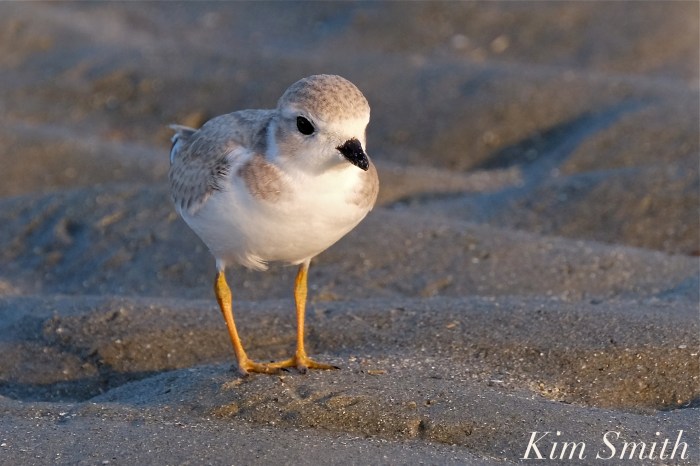 Bon voyage and safe travels Little Chick!
Bon voyage and safe travels Little Chick!
If I have neglected to thank you, please accept my sincere apology and please write and let me know so that I may add your name to the post. Thank you so much.
Spread The GMG Love By Sharing With These Buttons:


 Eclipse Day Sunrise Good Harbor Beach
Eclipse Day Sunrise Good Harbor Beach

